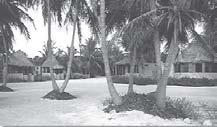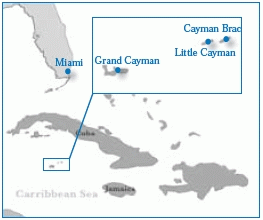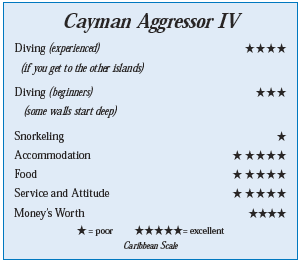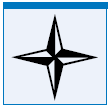Costa de Cocos, Xcalak, MexicoContents of this Issue: Costa de Cocos, Xcalak, Mexico The Most Likely Time for Your Regulator to Fail The Pelagian, Wakatobi, Indonesia A Different Experience at Wakatobi Resort Is the Travel Info You Need Online? Got a Medical Emergency? Call DAN Again and Again Eliminating Underwater Terrorists Safety Concerns on Liveaboard Boats Yongala Victim’s Husband Denies Murder, Sues Insurer Editorial Office: Ben Davison Publisher and Editor Undercurrent 3020 Bridgeway, Suite 102 Sausalito, CA 94965 good diving near the Belize border from the August, 2007 issue of Undercurrent
Dear Reader: In 1999, a past editor of Undercurrent opened the attractive Maya Ha resort near Mahahual, four hours south of Cancun. After a drawn-out battle with the resort’s developer, Maya Ha closed and was reopened a couple of years ago as the Maya Palms Dive Resort. I arrived in April for my third visit in several years, and was upset to learn that the staff was “too busy” to take me diving for the next two days. Every employee did the work of three people. The divemaster was also responsible for repairing everything, the chef was the groundskeeper, and everyone was helping with room renovations. Divers were at the bottom of the priority list –- at a so-named “dive resort.” After four days of lousy treatment, I checked out of Maya Palms and drove an hour south to Costa De Cocos. A flat, straight, paved road with Mayan ruins scattered along the way took me through low canopies of jungle full of butterflies smashing into my windshield and vultures eating iguana roadkill. I only had to drive on dirt roads a few miles. One wound through coconut groves to Costa de Cocos, sprawled across limestone beach.
The resort is in the small town of Xcalak, at the
southern end of the
Yucatan Peninsula
and a few miles
from the Belize
border. The sleepy
fishing village is
a 21st-century amalgam
of clapboard
shacks in the town’s
center and beachfront
McMansions
built by American
baby boomers along
the outskirts. It’s a bit like Cozumel 30 years ago. The Xcalak National Reef Park has banned fishing since 2000 so as a result, this part of the Great Maya Reef has more grouper, snapper and other large fish than Mahajual up the coast. It’s not as fishy as the South Pacific, so pelagic fans may not find enough variety. Another downfall is that some visitors are newly certified and fresh off the cruise ships at Mahajual. Their inexperience often shortened dives and sucked the divemasters’ attention during my week-long stay, so some dives were wasted. However, many sites filled with gigantic tarpon and friendly, curious turtles made it excellent for Caribbean diving. I was lucky to arrive ahead of the rainy season, so I got great visibility. The spur and grove formations, visible for more than 150 feet, looked like rolling hills surrounding underwater valleys with remarkable swim troughs and pristine, colorful bursts of coral. Plus, Xcalak’s relaxed atmosphere, other water-based activities and nearby Mayan ruins make a visit worthwhile for mellow divers. Xcalak has several small resorts and dive shops. The biggest is XTC Dive Center, which I used for my trip to Banco Chinchorro. But Costa de Coco is the only fullservice dive resort in town. Most dive sites are just five to 20 minutes from its dock. I set up my gear in the main dive boat, a 33-foot panga with twin 115-horsepower motors and a rack that could hold 10 tanks, all standard steel filled to 3,000 psi. The other boat was a 27-foot Albatross with twin 60-horsepower motors. Both had shade canopies but rides to the sights were only five to 20 minutes, and the surface intervals were back at the resort. On my first dive at La Poza, a five-minute boat ride from the resort, I dropped through the surface into a large, sandy bowl embedded in the reef. Stark boulders 150 feet apart ringed the bottom at 100 feet. A graceful eagle ray glided over a crack in the rock where a green moray was being cleaned by banded coral shrimp. Suddenly, a tarpon seven feet long approached me. It was the color of tarnished silver, with scales the size of tea saucers. At least 60 of these giants hung motionless or swam in lazy circles. I swam leisurely through them, close enough to touch. La Poza is a notable dive site because of these tarpon that hang out for doses of seafood churned in currents, making it happy hour year-round. My wall-side meandering found lobster holes, morays, schools of small fry and black coral. After ascending, I handed my gear back to the driver before climbing in via a short, narrow ladder hooked over the side. Costa de Cocos resembles a small tribal village of thatched-roof huts but a bit more upscale, being built with carved stone and glossy tropical wood. The 16 beachfront palapas are set far enough apart to ensure quiet and privacy but are centered about the main lodge with an outdoor bar and restaurant, where diving and fishing guests mingled with full-time expats at day’s end. My cabana, set 30 feet from the shore, was sparsely furnished but colorful with a green tile floor and yellow floral wallpaper, and cleaned thoroughly every day. The white-tiled bathroom was sparkling and always provided hot water. A fan and plenty of cross-ventilation made air-conditioning unnecessary. Every palapa offered a safe and a variety of lending books, although my selection was uninspiring. The resort had an on-site desalinization plant using reverse osmosis purification for tap water, and a wind-powered electricity generator ran 24 hours. The main lodge had a computer with free wireless Internet. Dives lasted 60 minutes and mostly didn’t go below 80 feet. Divemasters Steve, an
American, and Ramon, a Yucatan native, interviewed divers to place them in the appropriate
group. Even in non-drift dives, they made divers stay in a group and decided
when to ascend. They were good at pointing out notable marine life and made efforts
for everyone to maximize dive times -- Steve took an extra-large tank so the one
inexperienced person in my group could breathe from his octopus while the rest of us could enjoy the entire dive. Costa de Cocos’ other don’t-miss dive site is Chimineas, a large cave with two tubular-shaped holes stretching 80 feet to the surface. These chimneys illuminated La Catedral, a cave abundant with silversides hovering at the bottom, while barracuda and schools of silversides moseyed through the light beams. With no current, I easily descended to 60 feet and entered at the bottom into sheer rock walls encrusted with soft corals. I swam to the southern end of the cave, crammed with pillars of hard corals, and hovered over some huge black grouper. One four-footer was surrounded by a small city of cleaner fish and remora. The standard two-tank dive trip was finished by 1 p.m. but I booked some extra dives for the afternoon. Diving was a bit schizophrenic and unpredictable. For example, one morning, I rolled off the boat to encounter a pair of curious turtles that swam within 18 inches and stared me in the face. Then I checked out shoals of snapper and grunts, and the cleaning stations were crowded with creole wrasse. The safety-stop entertainment was a six-foot-wide stingray grazing in the sand below. However, on a one-hour dive the next afternoon, I only saw a dozen fish. But there was also fishing, kayaking and snorkeling to enjoy. One afternoon I drove to Mahajual to buy tourist tchotckes. It was supposedly a younger, hipper crowd than mellow Xcalak, but dull shopping and restaurants made it a low-end version of Cozumel. Another day, I lounged in a hammock in front of my palapa. The ocean breezes, well-kept grounds and a “mosquito trap” device meant no fear of being eaten alive. The shore is mostly shallow but I could plunge in for a dip off the dock near the main lodge. Both air and water temperatures were in the upper 80s. Costa de Cocos has the only restaurant and bar in town that is open every day, so it is the center of Xcalak’s otherwise nonexistent nightlife. I took many meals with the Randalls and shared cold cervezas at the bar with American expats and fellow divers, many of whom owned second homes there and came down every few months. Continental breakfast was included in the room rate and served as a buffet of fresh fruit, breads with jam, cereal and pancakes. Omelets, French toast and eggs could also be ordered. Lunch portions were gigantic and no item cost more than $6. The fish tacos were excellent, but I’d stay away from the burger. Fresh lettuce and tomatoes for salads were always in abundance. The dinner menu was not extensive but everything was delicious. Ilana makes pizza dough from scratch -- the lobster mango pizza is a local favorite but I also liked the pepperoni. All entrées came with Ilana’s homemade soup of the day and dessert. Her fresh strawberry shortcake with homemade whipped cream and shortbread crust was a perfect ending to my evening meal. The well-stocked bar featured cocktails like the Caribbean cruzer and mojito with fresh mint, although the wine selection was mediocre. On my last day of diving, I went to Banco Chinchorro, a mostly submerged coral atoll 300 miles long and 18 miles from the mainland. Wall dives on the outer reef went from 30 to 130 feet. XTC Dive Center was the only dive shop taking divers there but mandated a minimum of four people and calm conditions. It was expensive: $160 for three dives, lunch and snacks. (Costa de Cocos didn’t offer trips there, but their boats are too small to make the long ride a comfortable one anyway). We departed at 7:30 a.m. on the Tzimin-Ha, a custom-built, speedy dive boat. The sea was like a mirror for the 90-minute ride. Unfortunately, I couldn’t get away from inexperienced divers ruining a dive. The first dive at Cayo Centro featured six people with varying degrees of experience entering a fast-flowing current to 100-foot depths, so everyone got separated. For 10 minutes, I hovered behind a rock, waiting for Luis, the divemaster, but a shoal of two-foot long amberjacks and a motorcycle- sized black grouper joined me for the wait. Because the other divers had to be rounded up, the dive lasted only a half-hour. The second dive was better because we were more sheltered from currents. For the final, and best, dive, I backrolled and headed straight for the sandy bottom at 45 feet. I lay in a field of garden eels writhing in dense clusters, and even saw two of them fighting. As I finned along the edge of the reef, a shoal of huge parrotfish munched mouthfuls of white sand, resembling alien, turquoise-hued goats grazing on an otherworldly landscape. While I swam among them, a gray reef shark did a slow circle above. My safety stop was rife with snapper and grunts. I would have loved to do more at Chinchorro, but the cost was prohibitive. The constant currents bring lots of fish, though it has been heavily fished for decades. Another downside: The variety of shipwrecks from every time period is off-limits to divers, although snorkelers are free to get close. While XTC was good for my last day’s diving, Costa de Cocos was a well-oiled machine that knew what good customer service meant. With an armada of boats, competent boat drivers and divemasters, it can efficiently accommodate both fishers and divers. I liked that I could take advantage of other dive shops nearby and watersports if I so chose. The lack of Nitrox is a drawback, although XTC provides it for Banco Chinchorro trips, where it really counts. If you’re a relaxed diver who enjoys diving among healthy, pristine Caribbean coral and likes staying in sleepy, small beachfront villages, Xcalak is your place. It has better marine life, atmo-sphere, cheaper prices and more opportunity to mingle with locals than the cruiseship bustle of Mahajual. --S.V.M.
|

I want to get all the stories! Tell me how I can become an Undercurrent Online Member and get online access to all the articles of Undercurrent as well as thousands of first hand reports on dive operations world-wide
| Home | Online Members Area | My Account |
Login
|
Join
|
| Travel Index |
Dive Resort & Liveaboard Reviews
|
Featured Reports
|
Recent
Issues
|
Back Issues
|
|
Dive Gear
Index
|
Health/Safety Index
|
Environment & Misc.
Index
|
Seasonal Planner
|
Blogs
|
Free Articles
|
Book Picks
|
News
|
|
Special Offers
|
RSS
|
FAQ
|
About Us
|
Contact Us
|
Links
|
3020 Bridgeway, Ste 102, Sausalito, Ca 94965
All rights reserved.


 Most
visitors come for the bonefishing or to escape the developing
coastline farther north. Not that many come
to dive -- yet.
Most
visitors come for the bonefishing or to escape the developing
coastline farther north. Not that many come
to dive -- yet. Costa de
Cocos does not have Nitrox, nor does
any other dive resort in the southern
Yucatan. Steve told me the resort had no
plans to get it anytime soon. However,
XTC offers Nitrox for $12 a fill.
Costa de
Cocos does not have Nitrox, nor does
any other dive resort in the southern
Yucatan. Steve told me the resort had no
plans to get it anytime soon. However,
XTC offers Nitrox for $12 a fill.  Diver’s Compass: Costa de Cocos charges $60 nightly for a single
room, $65 for a double through December 15, then rates go to $70 and
$75; hotel tax is 12 percent . . . Two-tank dives are $60, an additional
dive is $45 but ask about discounts on multiple dives and
dive packages for four or more divers . . . The best time to dive is
springtime and early summer, before the rains and hurricane season
make visibility at dive sites unpredictable . . . Lunch costs between
U.S. $3 and $5; four-course dinner entrées range from $12 (vegetarian)
to $22 (steak and lobster) . . . For a change of pace, dine at
the Leaky Palapa, an upscale restaurant that locals raved about . . . Mayan ruins
are within driving distance both north and south of town, and even in Xcalak proper
. . . Costa de Cocos and XTC don’t take credit cards, only cash or online payments
via PayPal . . . Bring lots of cash because there are no ATMs, and the places that
do take cards often charge extra, from three to 15 percent . . . Costa de Cocos Web
site:
Diver’s Compass: Costa de Cocos charges $60 nightly for a single
room, $65 for a double through December 15, then rates go to $70 and
$75; hotel tax is 12 percent . . . Two-tank dives are $60, an additional
dive is $45 but ask about discounts on multiple dives and
dive packages for four or more divers . . . The best time to dive is
springtime and early summer, before the rains and hurricane season
make visibility at dive sites unpredictable . . . Lunch costs between
U.S. $3 and $5; four-course dinner entrées range from $12 (vegetarian)
to $22 (steak and lobster) . . . For a change of pace, dine at
the Leaky Palapa, an upscale restaurant that locals raved about . . . Mayan ruins
are within driving distance both north and south of town, and even in Xcalak proper
. . . Costa de Cocos and XTC don’t take credit cards, only cash or online payments
via PayPal . . . Bring lots of cash because there are no ATMs, and the places that
do take cards often charge extra, from three to 15 percent . . . Costa de Cocos Web
site: 